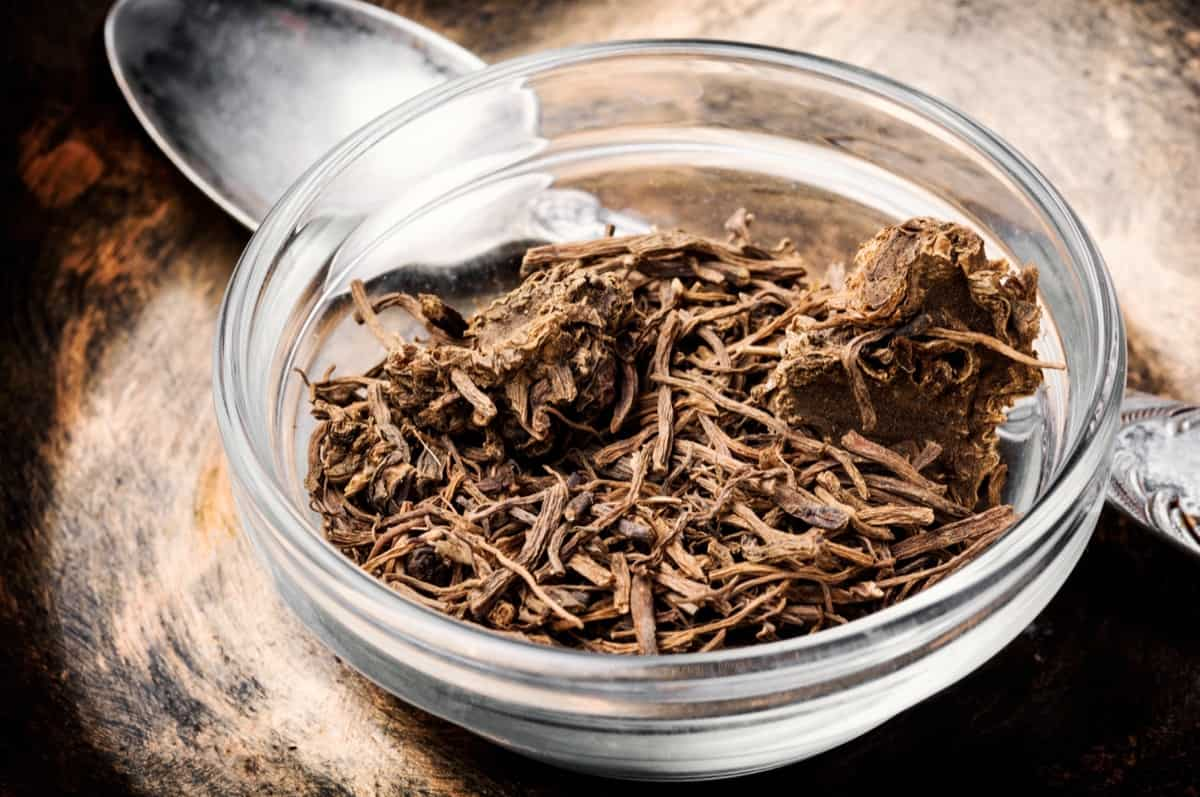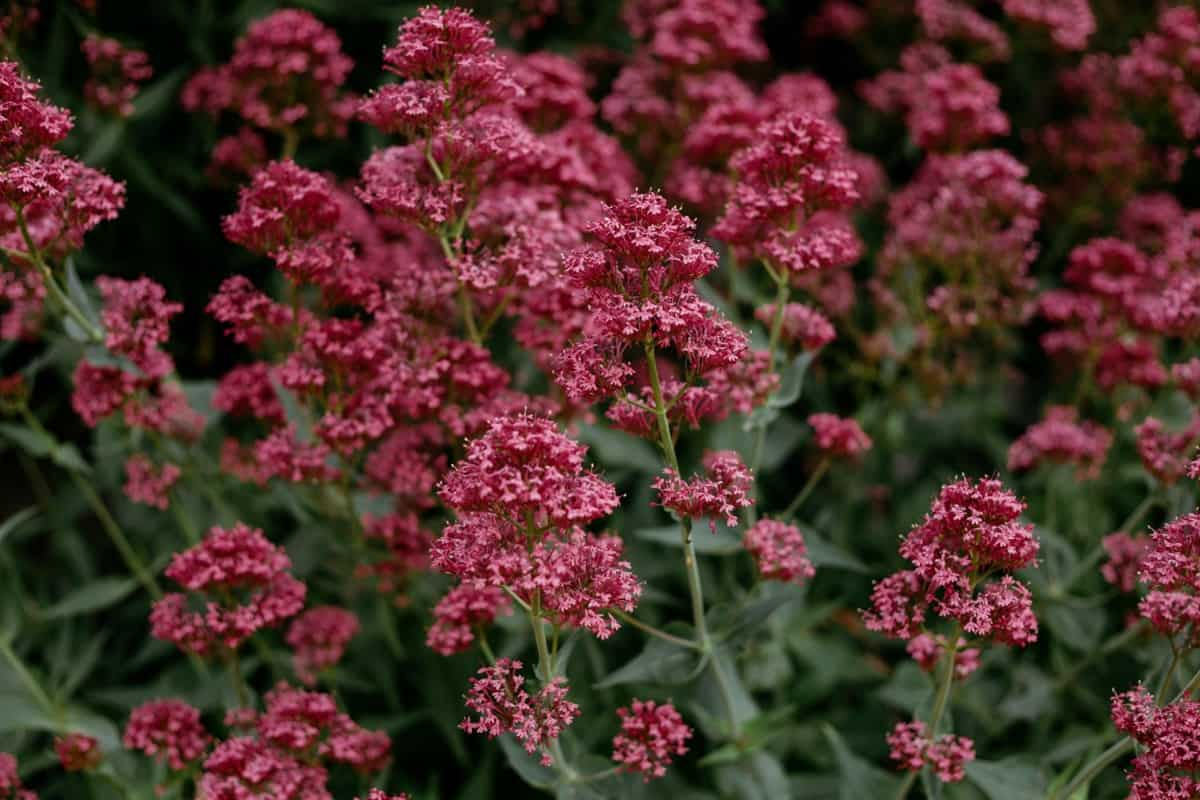Valerian (Valeriana officinalis, Caprifoliaceae) is a perennial flowering plant native to Europe and Asia. It is a tall perennial; Valerian (Valeriana officinalis) plant produces clusters of (usually) white flowers that attract butterflies and bees. Caring for Valerian plants is important to growing this beautiful and beneficial plant.

How to Grow Organic Valerian
Choosing the Right Organic Soil Mix for Valerian Plants
These plants thrive in well-drained soil that receives ample sunlight throughout the day, but they can also tolerate part shade if necessary. To ensure optimal growth and development, providing your Valerian with a soil mix that offers good drainage is important. This will prevent waterlogging and allow the roots to breathe properly.
A mixture of compost, perlite, or vermiculite and organic matter can create the perfect moisture retention and drainage balance. By selecting the right organic soil mix for your Valerian plants and providing adequate water, you’re setting them up for success in your garden or outdoor space.
Information about Growing Valerian
| Common Name | Valerian |
| Family | Caprifoliaceae |
| Soil Requirements | Valerian grows in various soils but prefers a moist, well-drained loam. |
| Days to Germination | 7-21 days |
| Light Preference | Sun/Part Shade |
| Hardiness Zones | Zones 3-9 |
| Harvesting & Storage | Harvest rhizome in the fall |
Step-by-Step Instructions for Growing Valerian from Seed
- Firstly, choose a sunny spot in your garden or prepare pots if you prefer to start growing Valerian indoors. Valerian prefers well-drained soil, so make sure it’s loose and fertile. You can also grow the Valerian in pots.
- Next, sow the Valerian seeds on the soil’s surface and lightly press them down. Keep the soil consistently moist, as Valerian seeds require moisture for germination.
- Within 10-16 days, you should see tiny seedlings emerging from the soil. These delicate plants will continue to grow and develop over time.
- As they mature, thin out or transplant them to about 1-2 feet apart to give each plant enough space to thrive.
- During the growing season, remember to remove any flower heads that appear. This will direct more energy toward developing robust rhizomes that can be harvested later.
- With proper care and regular watering, your Valerian plants will flourish throughout their growing season until they are ready for harvest.
Organic Fertilizers for Promoting Healthy Growth of Valerian
Compost – Compost enriches the soil with essential nutrients and improves its structure and water-holding capacity. You can make your compost by recycling kitchen scraps, yard waste, and other organic materials.
Worm Castings or Vermicompost – Earthworms produce these nutrient-rich pellets and contain beneficial microorganisms that enhance soil fertility. Spread a thin layer of worm castings around the base of your Valerian plants and gently work them into the soil.
Fish Emulsion – Made from decomposed fish remains, this liquid fertilizer boosts nitrogen, phosphorus, and potassium – essential elements that promote vigorous growth in Valerian plants.
Seaweed Extract – It is another fantastic organic fertilizer for Valerian. Packed with trace minerals like magnesium, iron, and zinc, seaweed extract helps strengthen plant roots and improve overall health.
Proper Watering Schedule for Valerian Plants in an Organic Garden
It is essential for the healthy growth of Valerian plants in an organic garden. These plants thrive in well-drained soil, so providing consistent moisture without overwatering is important. During the initial stages of planting, it’s crucial to keep the soil evenly moist to promote germination.
Once the plants have established themselves, they still require regular watering throughout their growing season. To prevent overwatering, always check the soil’s moisture level before watering. Stick your finger about an inch into the ground – if it feels dry at that depth, it’s time to water. Mulching around Valerian plants can help retain moisture in the soil and reduce weed growth.
Natural Pest Control Methods for Organic Valerian Cultivation
- Companion Planting: You can naturally repel pests by interplanting Valerian with certain companion plants. For example, planting Marigolds or Nasturtiums near your Valerian can deter aphids and other insects.
- Beneficial Insects: Encourage beneficial insects like ladybugs and lacewings to visit your garden by providing them with a habitat nearby. These predatory bugs will help keep pest populations in check.
- Neem Oil Spray: Neem oil is an excellent natural insecticide that can be used on Valerian plants to control pests. Dilute neem oil based on the instructions on the bottle and spray it onto affected areas of the plant.
- Homemade Insecticidal Soap: Mix a solution of mild liquid dish soap (without bleach) and water in a bottle, then apply it directly onto affected areas of the Valerian plant to kill soft-bodied pests like aphids and whiteflies.
In case you missed it: How to Grow and Care for Plum Tomatoes: A Step-By-Step Guide

Valerian Care Tips for Successful Cultivation in Your Garden
- Sunlight: Valerian prefers full sun or partial shade, so choose a location in your garden that receives 6 hours of sunlight daily.
- Soil: Ensure the soil is well-drained and rich in organic matter. Add aged manure to improve fertility and drainage.
- Watering: Valerian enjoys consistent moisture, so water regularly moistens the soil. Avoid overwatering the Valerian, as this can lead to root rot.
- Pruning: To promote healthy growth and prevent overcrowding, trim any dead or damaged leaves regularly throughout the growing season.
- Fertilization: While Valerian doesn’t require heavy feeding, you can apply an organic fertilizer once or twice during the growing season to provide nutrients for optimal growth.
Preventing Diseases and Common Issues in Organic Valerian Care
Powdery mildew disease appears as a white powdery substance on the leaves. To prevent this fungal disease, ensure adequate air circulation around the plants by spacing them properly. Additionally, avoid overhead watering as it can promote the spread of mildew. Another problem that may arise is root rot caused by overwatering or poorly drained soil. To prevent this, use a well-draining soil mix for planting and water your Valerian sparingly but deeply when necessary.
Pests such as aphids and slugs may also threaten your Valerian plants. To combat these pests organically, try companion planting for Valerian with herbs like lavender or rosemary, which deter aphids. You can use natural pest control ways like spraying soapy water on affected areas or setting up beer traps for slugs. Look for signs of nutrient deficiencies in your Valerian plants, such as yellowing leaves or stunted growth. This can be remedied by providing organic fertilizers rich in nitrogen, potassium, and phosphorus to promote healthy plant growth.
Companion Plants for Valerian and Their Benefits in Organic Gardening
- Chamomile: These two plants have similar growth habits and soil requirements, and chamomile also acts as a natural insect repellent, helping to keep pests away from your Valerian crop.
- Yarrow: It attracts beneficial insects like ladybugs and lacewings and helps improve the soil’s overall health by accumulating nutrients and breaking up compacted areas.
- Borage: To attract pollinators to your garden, consider planting borage alongside your Valerian. Borage flowers are highly attractive to bees and butterflies, ensuring that your Valerian plants have ample pollination opportunities.
- Lavender: Lavender not only adds beauty and fragrance to your garden but also acts as a natural pest deterrent due to its strong scent. Lavender and Valerian enjoy similar growing conditions with well-drained soil and full sun.
Harvesting and Drying Techniques for Valerian Roots and Leaves
Once your Valerian plants have matured, it’s time to reap the rewards of your hard work. Harvesting Valerian is a straightforward process that requires some care and attention to ensure the best quality yield. Harvesting and drying Valerian roots and leaves is crucial in utilizing this versatile plant for its medicinal properties. \
When harvesting the roots, it’s best to wait until the second or third year of growth when they have reached their maximum potency. Dig around the plant base, being careful not to damage the roots, and gently lift them from the soil. Once you have harvested your Valerian roots, cleaning them thoroughly is important.
In case you missed it: How to Grow and Care for Organic Rosemary: Guide to Planting to Harvest

Remove any excess dirt and trim off any damaged or discolored parts. After cleaning, you can choose between air-drying or using a dehydrator. If you prefer air-drying, spread out your cleaned Valerian roots on a clean surface in a well-ventilated area away from direct sunlight. Allow them to dry completely for about 2 weeks or until they become brittle. Store them in sealed containers away from moisture and direct light to preserve their potency for future use.
Conclusion
Valerian belonging to the Caprifoliaceae family is a remarkable perennial flowering plant. This tall beauty adds elegance to any garden or landscape. Caring for Valerian plants is relatively simple. They thrive best in well-drained soil with plenty of sunlight or partial shade. Regular watering is essential for their growth and development.
- Feed Your Flock for Less: Top 10 Tips to Save on Chicken Feed
- Ultimate Guide to Ossabaw Island Hog: Breeding, Raising, Diet, and Care
- Hatching Answers: The Top 10 Reasons Your Chickens Aren’t Laying Eggs
- Eggs and Economics: Breaking Down the Cost of Raising Backyard Chickens
- Defend Your Greens: Proven Methods to Keep Iguanas Out of Your Garden
- Ultimate Guide to Cinnamon Queen Chicken: A Comprehensive Guide for Beginners
- Ultimate Guide to California Tan Chicken: Breeding, Raising, Diet, Egg-Production and Care
- Ultimate Guide to Marsh Daisy Chicken: Breeding, Raising, Diet, and Care
- 10 Types of Chicken Farming Businesses You Can Start for Profits